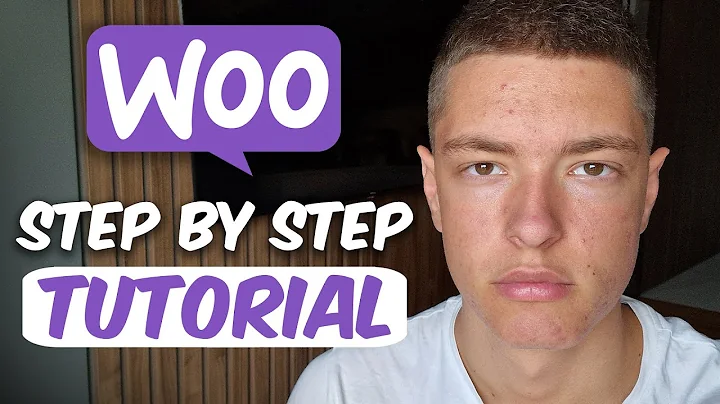The Complete Guide to Starting an Ecommerce Store
Table of Contents
- Introduction
- Step 1: Creating a Shopify Account
- Step 2: Finding a Winning Product
- Step 3: Importing Products to Your Shopify Store
- Step 4: Optimizing Your Product Page
- Step 5: Setting Up Shipping and Delivery
- Step 6: Customizing Your Online Store
- Step 7: Creating Facebook Ads
- Step 8: Testing and Analyzing Your Facebook Ads
- Step 9: Scaling Your dropshipping Business
- Conclusion
Starting Your Own Ecommerce Store: A Step-by-Step Guide
Are you looking to start your own ecommerce store? Do you want to leverage the dropshipping business model for a profitable online venture? Look no further! In this comprehensive guide, we will walk you through the essential steps to help you establish a successful ecommerce store from scratch.
Step 1: Creating a Shopify Account
The first step in starting your ecommerce store is to create a Shopify account. Shopify is a popular ecommerce platform that allows you to easily set up and manage your online store. By clicking the link in the description, you can access an exclusive offer for Shopify, costing only $1 for all plans. This offer can save you $38 per month, enabling you to allocate those savings towards other crucial aspects of your business.
Step 2: Finding a Winning Product
Before diving into creating your online store, it is important to identify a winning product. You want to select a product that stands out, offers value to customers, and has the potential for high demand. Consider factors like uniqueness, market saturation, user-generated content capability, visual appeal, emotional connection, and longevity when evaluating potential products. To discover winning products, you can leverage platforms like TikTok and Amazon using relevant search phrases.
Step 3: Importing Products to Your Shopify Store
Once you have identified a winning product, the next step is to import it from a supplier to your Shopify store. One efficient way to streamline this process is by using AutoDS, an application that allows you to import products from platforms like AliExpress. AutoDS not only facilitates product importation but also serves as a fulfillment service, automating order processing and tracking for a smoother customer experience.
Step 4: Optimizing Your Product Page
To convert visitors into buyers, it is essential to create a visually appealing and informative product page. Make sure your product page contains all the necessary details, images, and compelling descriptions that instill trust and generate interest among potential customers. To simplify this process, tools like Chatbot and AI-powered copy generators can assist you in creating engaging and persuasive product descriptions and page content.
Step 5: Setting Up Shipping and Delivery
Efficient shipping and delivery are vital for a successful ecommerce store. Set up shipping rates and delivery options that align with customer expectations and your business goals. Offer free shipping on orders above a certain value to incentivize larger purchases, and provide priority processing options for customers who are willing to pay extra for faster delivery. Consider using various shipping apps and services available on Shopify to optimize the shipping process.
Step 6: Customizing Your Online Store
To create a unique brand identity and engage customers, it is important to customize your online store. Choose a visually appealing theme, create a captivating logo, and design a user-friendly website layout that showcases your products effectively. Use color schemes, fonts, and imagery that align with your brand's identity and appeal to your target audience. Ensure that your online store is optimized for mobile devices to cater to the increasing number of mobile shoppers.
Step 7: Creating Facebook Ads
To drive traffic and generate sales, it is essential to advertise your ecommerce store effectively. Facebook Ads is a powerful tool for targeting your ideal audience and promoting your products. Create engaging ad creatives, including attractive images or videos, persuasive ad copy, and compelling call-to-actions. Use Facebook's detailed targeting options to reach potential customers who are likely to be interested in your products.
Step 8: Testing and Analyzing Your Facebook Ads
Once your ads are up and running, it is crucial to continuously test and analyze their performance. Monitor key metrics such as click-through rates, conversion rates, and return on ad spend to determine which ads are performing well and generating sales. Use the data to optimize your targeting, ad creatives, and ad placements to maximize your ad campaign's effectiveness.
Step 9: Scaling Your Dropshipping Business
As you start seeing success with your ecommerce store, you can explore ways to scale your dropshipping business. This may involve expanding your product line, targeting new market segments, or leveraging other advertising platforms like Google Ads or influencer marketing. Continuously adapt and refine your strategies based on customer feedback and market trends to sustain and grow your business.
Conclusion
Starting your own ecommerce store can be a lucrative venture if you follow the right steps and strategies. By creating a Shopify account, finding a winning product, optimizing your online store, and running effective Facebook ad campaigns, you can establish a successful dropshipping business. Remember to continuously test, analyze, and refine your strategies to stay competitive in the ever-evolving ecommerce landscape. Good luck on your entrepreneurial journey!
Highlights
- Creating a Shopify account is the first step to starting your ecommerce store.
- Finding a winning product involves considering factors like uniqueness, market saturation, and user-generated content capability.
- Import products to your Shopify store using AutoDS for streamlined order processing and fulfillment.
- Optimize your product page with visually appealing content and compelling descriptions.
- Set up shipping and delivery options that align with customer expectations and business goals.
- Customize your online store to create a unique brand identity and engage customers effectively.
- Drive traffic and generate sales through targeted Facebook ad campaigns.
- Continuously test, analyze, and optimize your ads for better performance.
- Scale your dropshipping business by expanding product lines and exploring new marketing channels.
- Adapt and refine your strategies based on customer feedback and market trends.
FAQ
Q: How much does it cost to create a Shopify account?
A: By clicking the link in the description, you can access an exclusive offer to create a Shopify account for only $1.
Q: How can I find winning products for my ecommerce store?
A: Use platforms like TikTok and Amazon to search for unique products that create a strong desire among potential customers. Consider factors like uniqueness, market saturation, and user-generated content capability.
Q: What is AutoDS, and how can it help with importing products?
A: AutoDS is an application that allows you to import products from platforms like AliExpress to your Shopify store. It also serves as a fulfillment service, automating order processing and tracking for a smoother customer experience.
Q: How can I optimize my product page for better conversions?
A: Create a visually appealing product page with compelling descriptions and images that instill trust in potential customers. Use tools like Chatbot and AI-powered copy generators to assist in creating engaging and persuasive content.
Q: What is the importance of setting up shipping and delivery options?
A: Efficient shipping and delivery are essential for a successful ecommerce store. Set up rates and options that align with customer expectations and your business goals, including free shipping and priority processing.
Q: How can I create effective Facebook ad campaigns for my ecommerce store?
A: Use Facebook Ads to target your ideal audience with engaging ad creatives, persuasive ad copy, and compelling call-to-actions. Continuously test and analyze the performance of your ads to optimize their effectiveness.
Q: How can I scale my dropshipping business?
A: Explore options like expanding your product line, targeting new market segments, or leveraging other advertising platforms like Google Ads or influencer marketing. Continuously adapt and refine your strategies based on customer feedback and market trends.



















